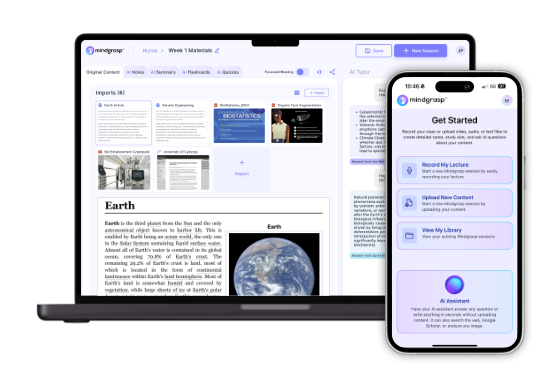
Cramming for chemistry isn't ideal, but we can help you make it work!
Focus on high-impact topics like periodic trends and molecular structure first. Gather your notes, textbook, and formula sheets, then create a quick study plan.
Don't just re-read—use active recall with flashcards and problem-solving instead. Draw diagrams for complex concepts, and take short breaks to stay sharp.
The right approach can turn last-minute studying into meaningful learning.
Why cramming for chemistry feels harder than other classes
While chemistry has a reputation as one of the toughest subjects to cram for, understanding why it feels so different from other classes can help us tackle it more effectively. Unlike subjects where you can simply memorize facts, chemistry demands that we grasp complex concepts and relationships.
When we're cramming chemistry, we're not just learning information—we're trying to understand three-dimensional molecular structures and visualize reactions that we can't see. Make sure you use study guides that break down these tricky concepts into manageable chunks.
And unlike history or literature, chemistry requires applying multiple formulas and principles simultaneously. That's why practice exams are essential—they help us connect those interconnected topics like stoichiometry and thermodynamics.
Chemistry doesn't just want us to remember; it wants us to understand and solve problems!
Boost Your GPA Faster with Mindgrasp
Instantly turn your class notes into smart summaries, flashcards, and quizzes—study less, learn more, and ace your exams.
Try it FreeStep 1: Determine what to study (Prioritize high-impact topics)
Since we're facing a chemistry exam with limited time, we need to be strategic about what we study. Not all chemistry topics are created equal when it comes to exams!
Focus your note taking on these high-impact topics that show up repeatedly:
- Periodic trends (they connect to everything!)
- Molecular structure and geometry
- Intermolecular forces
- Electron configurations
- Mass spectrometry calculations
Why these? They're the foundation that other concepts build upon.
When studying chemistry under time pressure, group related concepts together - like keeping all bonding types in one section of your notes. Trust us, your brain will thank you later!
Understanding the relationship between atomic structure and periodicity gives you more bang for your buck than memorizing random facts.
Step 2: Gather your chemistry materials and make a quick plan
Now that you've identified what to study, it's time to gather your battle gear! Successful cramming requires having every single resource at your fingertips:
- Class notes and textbooks
- Problem sets and old quizzes
- Periodic table and formula sheets
- Calculator and scratch paper
- Study guides you've made (or can quickly make)
Next, create a bare-bones study plan. We need to put in the time efficiently, so divide your remaining hours by topic priority. For example: "7-8pm: Periodic trends, 8-9pm: Balancing equations."
Organize your workspace too! Remove distractions and keep essential tools nearby. Post sticky notes with formulas you need to remember in visible spots.
Step 3: Use active recall to study chemistry (Don’t just re-read)
Ditch the passive re-reading habit that tricks you into thinking you're studying! Active recall is your secret weapon for cramming chemistry effectively. Instead of staring at your notes, challenge your brain to retrieve information on its own.
Go ahead and grab some flashcards for those tricky formulas and reaction mechanisms. Quiz yourself relentlessly! Try solving problems without peeking at your notes first, then check your work to spot weaknesses.
We've found that teaching concepts out loud—even to your stuffed animals or roommate—helps cement your understanding. It quickly reveals what you actually know versus what you think you know.
Finally, take practice quizzes under exam-like conditions. This trains your brain to perform under pressure, which is exactly what you'll need tomorrow!
Step 4: Break down complex chemistry processes with diagrams
Your brain processes visuals much faster than text—making diagrams your best friend when cramming chemistry! When you're stuck on reaction mechanisms or complex processes, grab some paper and start drawing.
Try these diagram types to simplify tough concepts:
- Flowcharts for breaking down multi-step processes like photosynthesis
- Lewis structures to visualize molecular geometry and electron distribution
- 3D sketches (even simple ones!) to understand spatial relationships in molecules
- Energy graphs to see how reactions progress
Don't worry about artistic skills—even stick figures work! The act of creating diagrams forces you to understand each step before you can draw it.
Plus, when test time comes, you'll recall these visual cues much faster than pages of notes you've reread.
Step 5: Leverage AI study tools like Mindgrasp AI for chemistry
While traditional study methods have their place, AI tools for chemistry students like Mindgrasp AI can dramatically cut down your cramming time by personalizing your chemistry review.
Try Mindgrasp for Free!
Experience an easier, faster way to boost your GPA. Sign up now to try Mindgrasp AI for free and see how AI-powered learning transforms your study routine.
Try it FreeWe've found that these smart tools can:
- Generate practice problems specifically for topics you're struggling with
- Summarize complex reactions or concepts into bite-sized explanations
- Provide immediate feedback when you're working through difficult problems
What's really helpful is how Mindgrasp analyzes your responses to identify your weak spots. Instead of reviewing everything, you can focus on what you don't know—perfect for last-minute cramming!
Before your exam, try using the platform's practice tests to simulate actual test conditions. It's like having a tutor who's available 24/7 and knows exactly what you need to work on.
Step 6: Memorize key terms and definitions with flashcards & mnemonics
Chemistry terms can feel like learning a foreign language, but flashcards and mnemonics become your secret weapons when time's running out. We recommend creating cards with the term on one side and its definition on the other—simple but effective!
Don't just memorize words; use memory tricks that stick. Try acronyms like "Fried Chicken Never Arrives" to remember that ionization energy increases from Fr to Ne. Making these connections helps information stay put when you're stressed during the exam.
A few quick tips:
- Shuffle your cards regularly to avoid memorizing the order
- Add diagrams for visual concepts (molecular geometry is perfect for this)
- Schedule short, focused flashcard sessions
- Review right before bed—your brain keeps working while you sleep!
Step 7: Practice with questions and problems
Now that you've built your flashcard arsenal, let's put that knowledge into action. Solving practice problems is where the real learning happens!
We recommend:
-
Working through a variety of problems across different topics (don't just stick to what you're good at)
-
Focusing on understanding each step of the solution—not just memorizing answers
-
Ignoring irrelevant information in word problems (chemistry exams love throwing in extra details!)
-
Finding past exams or practice tests to get comfortable with the format
-
Forming a quick study group to tackle tough problems together
Step 8: Take short breaks and look after yourself
Even the most dedicated chemistry crammers need to recharge! We recommend taking short breaks every 25-30 minutes during your study sessions. This isn't wasting time—it actually helps your brain process information better and prevents burnout.
During breaks, try:
- Standing up and stretching for a minute or two
- Taking a quick walk around your room or house
- Drinking water (stay hydrated, it helps your brain work!)
- Having a small, healthy snack for energy
Don't forget about sleep! Your brain needs it to cement all those chemical formulas in your memory.
And when you're feeling stressed, try a minute of deep breathing or mindfulness—it'll help calm your nerves and get you back into study mode refreshed and focused.
Cramming for chemistry in 1 Day, 3 Days, or 1 Week
We've got strategies whether you're panicking with just 24 hours left or planning ahead with a full week.
If you're down to your last day, focus on high-yield topics like periodic trends and tackle practice problems instead of rereading notes.
With three days or a full week, you'll want to create a structured schedule that divides major topics into manageable chunks—just remember that active learning through flashcards and teaching concepts works better than passive reading regardless of your timeframe.
Cramming for chemistry with one week left
With a full week remaining before your chemistry exam, you've got enough time to organize a strategic study plan that can truly make a difference.
Let's make the most of it!
Here's what we recommend:
- Block out daily study sessions (1-2 hours minimum) focusing on one major topic each day.
- Prioritize high-yield concepts like periodic trends and molecular bonding—these show up everywhere!
- Don't just read passively—teach concepts to a friend or make flashcards to cement your understanding.
- Practice with past exams or similar questions daily—it's the best way to prepare for what you'll actually face.
- Use visual aids for tricky topics like molecular geometry—sometimes seeing a 3D model makes all the difference.
Cramming for chemistry with three days left
Three days before your chemistry exam might feel like you're racing against the clock, but trust us—it's still enough time to make significant progress.
Start by focusing on those core concepts—periodic trends, bonding, and molecular structure—that form the backbone of chemistry.
Each day, carve out time for practice problems. Mix up easy ones with tougher challenges to build confidence and sharpen your skills.
Don't forget to use all your resources: notes, textbooks, and online tutorials can help clarify those tricky topics.
If possible, grab a study buddy or form a small group. Explaining concepts to others cements your understanding—plus, it's way less boring than studying alone!
Remember to take breaks and get enough sleep. A rested brain learns better than an exhausted one.
Cramming for chemistry with one day left (24 hours)
So you're down to your last 24 hours before the chemistry exam—it's crunch time! At this point, you need to be super strategic with your limited time.
Focus exclusively on the most critical concepts—mass spectrometry, periodic trends, and molecular structure should top your list.
Don't try to learn anything new! Instead:
- Spend 30-45 minute blocks actively recalling information (try explaining concepts out loud—yes, actually talking!)
- Take 5-minute breaks between sessions to keep your brain fresh
- Work through practice problems on electron configuration and molecular polarity
- Use Lewis structures and other visuals to cement your understanding
- Review your notes one final time before bed
Common mistakes to avoid when cramming and how to fix them
When chemistry exams loom on the horizon, we often fall into predictable traps that can sabotage our study efforts.
Let's fix these common mistakes:
-
Don't just memorize formulas! Instead, understand why they work—it'll stick better in your brain during the test.
-
Cramming without practice is useless. Solve problems regularly, not just the night before.
-
Always review your practice problems—explain each step out loud and identify what information matters.
-
Don't study alone! Find study buddies who can explain concepts you're fuzzy on (and vice versa).
-
Reading notes passively won't cut it. Try active learning: make flashcards, teach concepts to your roommate, or draw diagrams.
Your brain needs to engage with the material, not just stare at it.
Final Takeaways on chemistry cram studying
Although cramming isn't ideal, we've all been there—frantically trying to pack chemistry knowledge into our brains before a big test. If you're in this situation, focus on what matters most: periodic trends, atomic radius, and electron configurations—these show up everywhere!
Create quick summary sheets with formulas and definitions that you can review repeatedly. Don't just read—practice problems that make you explain your reasoning. This cements your understanding way better than passive review.
If possible, grab a study buddy! Teaching concepts to someone else reveals gaps in your knowledge.
And don't forget to look at past exams to get familiar with question styles.
Download Mindgrasp from the App Store
Access Mindgrasp at your desk for in-depth research and writing projects, or use the mobile version to easily access your content on-the-go or record live lectures.
Download the iOS App
